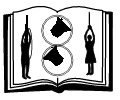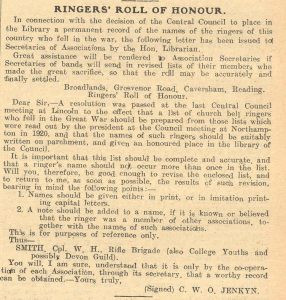
|
Ringing History Hub |

|
Ringing History Hub |
History of the Rolls of Honour
| |||
| It seems from the material below that in 1920 the roll consisted of a list of about 950 names. By 1923 this had grown to almost 1,100. The Memorial Book was completed and presented to the Council during the 1924 meeting. The statement at the 1929 meeting that "this book had been brought up to date" may refer to the addition of names at the ends of some existing pages, which consequently are not in alphabetical sequence. It is believed that these names brought the total number to 1077 as can be seen today in the Book itself and also shown on this website as the Main List. At the 1995 Council meeting it was agreed that 38 names from the Truro Guild should be added. This resulted in the creation of the Addendum which actually contains 36 names. The "supplement" mentioned in the minutes of the 2005 meeting presumably refers to the Second Addendum, which contains the names of 20 ringers from Kent. The inclusion of the two Addenda in the Memorial Book brought the total number of names to 1133. Work is now under way to correct and update an electronic copy of the Book entitled Great War Casualties. This is a single list in alphabetical order whose contents can also be viewed in sections by Tower within each Society represented, by Cemetery/Memorial, by Regiment or by Rank. Peter Trotman (November 2007) Extract from The Central Council of Church Bell Ringers 1891-1991, A Centenary History by W. T. Cook: “The Council naturally wished to honour the memory of ringers who had been killed during the war, so in 1919 a start was made on collecting their names from the Associations. "When the Council met in Northampton in 1920, the members stood in their places at noon as the names of nearly a thousand ringers were read out to the sound of tolling of bells in the neighbourhood; this took nearly half an hour. "During the 1921 London meeting, the members went from Church House across to Westminster Abbey, and held a brief service round the tomb of the Unknown Soldier. The President laid on the tomb a wreath with the inscription, " A token of deep respect from the Church Bell Ringers of England." A course of Stedman Caters was then rung on handbells. 
"In 1922 it was suggested that this Roll of Honour of ringers who had fallen in the war be preserved in a more permanent form, and the Librarian, Rev. C.W.O. Jenkyn, who had served as Chaplain to the forces on the Western Front, was empowered to make enquiries as to the cost of this. Jenkyn immediately set about trying to ensure that the list was as complete and accurate as possible, byapplying to Association Secretaries for details. As usual, the response was very varied, but eventually he had collected nearly 1,100 names, and made enquiries as to the best way of preparing a permanent record. The sum of £20 was voted from the Council's funds to get the work done. The result was a beautifully written and illuminated volume, the work of Albert Cousins, a professional writer from Cambridge; it was said by an art expert from South Kensington to be "the most beautiful example of modern writing and illumination which had ever come into the museum.” The book was placed in the library of St. Paul’s Cathedral for safe keeping." | |||
|
Copyright © 2003-2025 Central Council of Church Bellringers |
Log in | Site map |